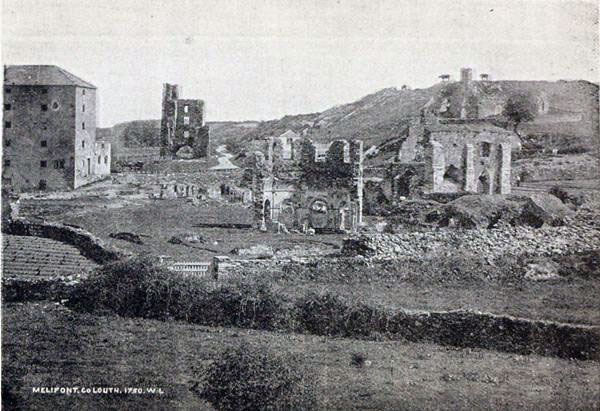E-text prepared by the Online Distributed Proofreading Team
()
from page images generously made available by
Internet Archive
(http://www.archive.org)
| Note: | Images of the original pages are available through Internet Archive. See http://www.archive.org/details/mellifontabbeyco00dubl |

General View.
From Photo by W. Lawrence, Dublin.
MELLIFONT ABBEY,
CO. LOUTH:
Its Ruins and Associations.
A GUIDE
AND
POPULAR HISTORY.
| “A house of prayer, once consecrate To God’s high service—desolate! A ruin where once stood a shrine! Bright with the Presence all divine!” (W. Chatterton Dix.) |
Permissu Superiorum.
Published by
JAMES DUFFY & CO., Ltd., DUBLIN,
FOR
THE CISTERCIANS,
MOUNT ST. JOSEPH ABBEY, ROSCREA.
1897.
Printed by
Edmund Burke & Co.,
61 & 62 GREAT STRAND STREET, DUBLIN.
INTRODUCTION.
In the following pages an attempt is made to describe the ruins ofMellifont as they now appear, and to explain the uses, or probable uses,that the buildings yet remaining must have served when the monks dweltthere. Obviously, some important structural alterations were made whenchanging the venerable Abbey into a fortified residence; nevertheless theruins exhibit, on the whole, the characteristics of the primitive plan andstyle in which Mellifont, as well as all the Cistercian monasteries bothin this country and on the Continent, were built. The explanation isfounded on reliable authority, being gleaned from most authentic sources,such as, Les Monuments Primitifs de La Règle Cistercienne, which is acopy of the Rule drawn up by the Founders of the Order; the MonasticonCisterciense; Violet Le Duc; Jubainville, Etudes sur l’Etat intérieurdes Abbayes Cisterciennes au XII. et au XIII. siècle; Meglinger, IterCisterciense; La Vie de Saint Bernard, by Vacandard, etc.
As no Records, or Chronicles of Mellifont now exist, the historical partof the compilation has been derived from different sources, chiefly fromour old Annals—The Annals of the Four Masters; those of Boyle, ofSt. Mary’s Abbey, Dublin; Clyn and Dowling’s; and of Clonmacnois;[Pg vi]Ware’s Bishops, etc.; the Miscellany of the Archæological Society;Ussher’s Sylloge; Morrin’s Calendars of Patent Rolls, etc. The partrelating to disciplinary subjects was drawn principally from Martène’sThesaurus Ane BU KİTABI OKUMAK İÇİN ÜYE OLUN VEYA GİRİŞ YAPIN!
Sitemize Üyelik ÜCRETSİZDİR!